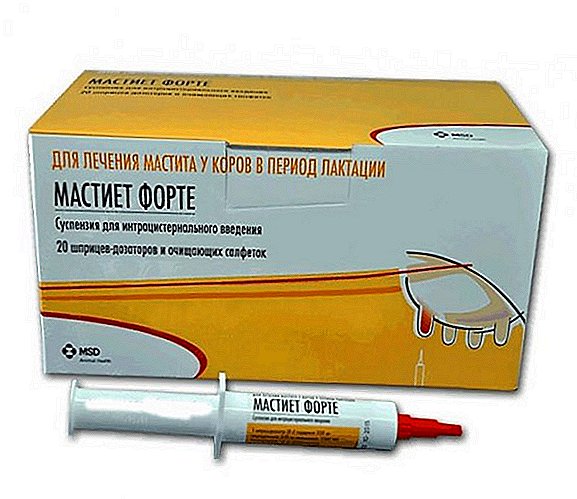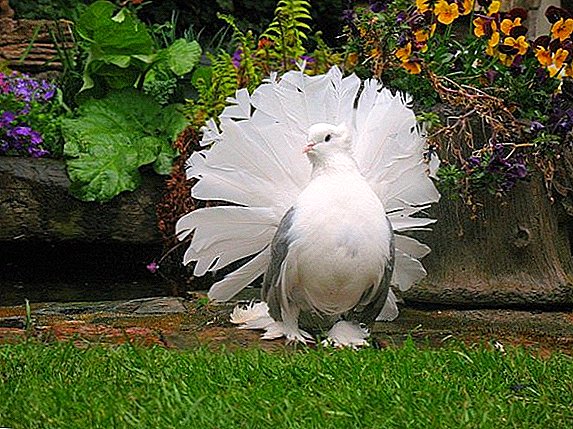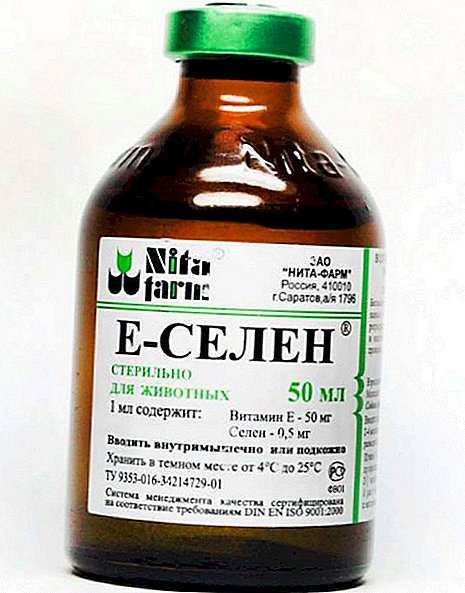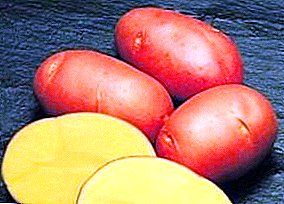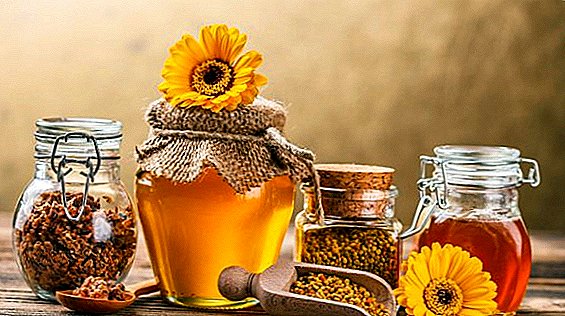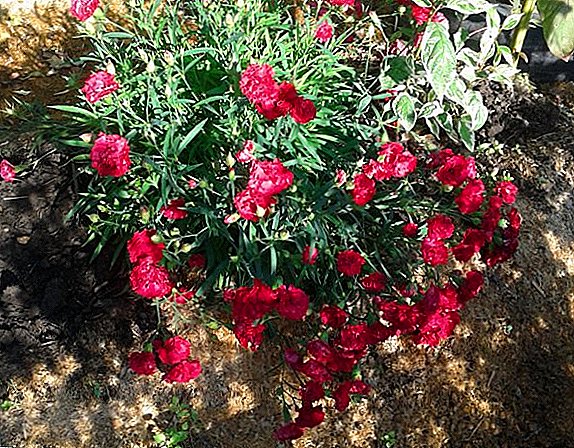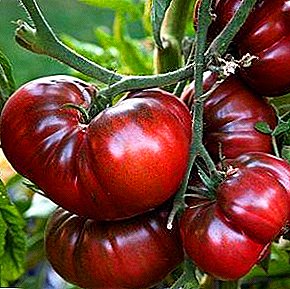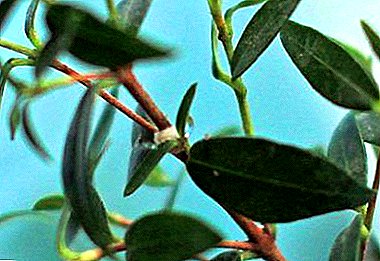
House myrtle - quite unpretentious houseplant that does not require complex care.
With timely transplanting and regular watering, as a rule, rarely gets sick.
However, no breeder is insured against annoying blunders.
What diseases can strike a flower, why leaves in myrtle fall and dry, types of pests - all this and not only you will find in our article.
Diseases
 Most of the problems with this plant are caused by improper care, diseases of the myrtle are most often manifested in drying and leaf fall, less often in the appearance of stains on them.
Most of the problems with this plant are caused by improper care, diseases of the myrtle are most often manifested in drying and leaf fall, less often in the appearance of stains on them.
IMPORTANT: Myrtle is necessary often, but moderately watered and fertilized every summer, regardless of its type.
If your myrtle has blackened leaves or the ends of the shoots, the reason for excessive watering: constantly flooding the flower, you do not give the roots to receive oxygen, which leads to their decay.
This, in turn, badly affects the health of the crown of the plant.
There are two possible ways out: loosen the ground and less often water the flower or transplant it into a drier soil (with a lower content of moisture-absorbing components).
ATTENTION! The water in the pan should in no case be stagnant.
If the leaves began to turn yellow, it means that the myrtle is either dried out as a result of improper watering or dry air, or is in too bright sun.
REFERENCE: He feels best on the east or west window. The overdried plant can be reanimated, providing him frequent watering. If the cause is still in dry air, if possible, move the flower away from the battery and daily spray it with a spray bottle.
 All types of myrtle belong to the group of decorative leafy trees.
All types of myrtle belong to the group of decorative leafy trees.All of them are interesting and have their own characteristics. We bring to your attention useful information about Araucaria and Cypress.
What to do if showered leaves?
If the myrtle suddenly began to lose leaves, this often happens with Lemon myrtle, pay attention to the water you water it. The best water for irrigation is suitable settled water, because it already has no chlorine, which damages the condition of the leaves. Also, the shedding of leaves can be the result of drying out, move it to a cooler place.
ATTENTION! Myrtle acutely reacts to the drying of the soil, do not forget to regularly water the plant.
If you started to crumble immediately after purchase, This is due to the stress experienced by the plant due to the change in conditions. Provide sufficient moisture to the flower.
REFERENCE: Small young plants can be kept under the plastic until the crown condition improves.
The health of the plant can deteriorate sharply after transplantation, because it is stressful for the flower. Provide him with the most correct care, and soon he will recover.
IMPORTANT: Myrtle is evergreen, and it does not have a seasonal leaf fall. Therefore, answering the question why the leaves of the myrtle fall off — look for the cause in improper care or insect pests (they are described in detail below).
What to do if the foliage dried up?
 Most often, the causes of drying myrtle lie in the wrong watering or insufficient humidity in the room.
Most often, the causes of drying myrtle lie in the wrong watering or insufficient humidity in the room.
Plant Demanding watering: the ground in the pot should be slightly damp all the time, otherwise the leaves will dry and curl.
It is necessary to water a plant daily, however, in the autumn-winter period, the frequency of watering can be reduced (unless, of course, the flower is not in a hot place). The problem of dry air is solved by daily spraying, in the heating season you can put a container with water on the battery.
ATTENTION: For irrigation and spraying should use only distilled water.
Also, drying can cause excessive feeding, in this case it is necessary to transplant the flower in a new ground, washing the roots. This is a risky procedure, but it is she who can save the plant from death.
Diseases and pests on the photo:




Temperature exposure
Heat and cold are equally dangerous and can lead to drying and death of the plant, if not taken measures of resuscitation.
As mentioned earlier, the heat and dry air myrtle sheds leaves - what to do to help the plant? You can water and spray the plant daily with a spray bottle, or in extreme cases, a plastic bag can be put on the flower to preserve moisture.
It is resistant to fluctuations in air and endures drafts, in addition, in the winter it is recommended to keep in a cool place.
REFERENCE: In winter, it is recommended to move the myrtle pot to a room with a temperature of about 15 degrees.
It is more difficult to freeze a myrtle, than to dry. However, such a misfortune can occur if you leave the flower in the cold by the open window or on the balcony. The reaction to the cold does not take long: most leaves will dry out literally during the day.
So what to do if the myrtle dries up? There is a chance to save the plant if the roots did not have time to freeze. The algorithm of first aid to the frozen one is as follows: cut off all dried branches, sprinkle live branches with a biostimulant (for example, with Appin) and cover with polyethylene.
 Decorative leafy plants, to which the myrtle belongs, are very diverse.
Decorative leafy plants, to which the myrtle belongs, are very diverse.On our site you can get acquainted with such groups as False Palm and Predatory Plants.
Pests
It happens that the care is correct, the temperature and humidity are normal, and the plant suffers. What if the myrtle dried up or dropped all the leaves? In the dense crown of a home plant many small pests like to settle.
Myrtle of any kind, and Kommunis and Myrtle ordinary, affect the same insect pests that harm the rest of indoor plants. These are aphid, scytworm, mealybug, thrips, whitefly and spider mite.
Aphid settles in colonies on the back of the leaves and feeds on their juice, because of which the leaves curl and dry. You can get rid of aphids by spraying the plants with a special insecticide drug (for example, Aktara). Before spraying, remove insects from the leaves by washing the flower under the shower with the crown down.
Shchitovka, like aphid, sucks the juice from the plants. Characteristic signs of infection with the shield are the appearance of sticky plaque on the leaves and shoots. If you find flakes on a flower, you must remove them with a cloth or a soft toothbrush moistened with soapy water, and then treat the plant with an insecticide (recommended by Actellic).
Mealybug clearly visible on plants, it can be calculated by the white fluffy bloom on the leaves and branches. The detected pests must be removed, and the plant itself must be watered with Aktar.
IMPORTANT: Insecticide preparations are very toxic, strictly follow the concentration indicated in the instructions.
Thrips - a small insect, the presence of which can be determined by light spots on the upper side of the leaves and dark points on the back. Trips harms not only the leaves, but also the buds, so if you want the myrtle to please you with abundant blooms, you need to get rid of thrips as soon as possible. The folk method is to pour the plant with infusion of garlic or tobacco dust, but a more effective way is to treat it with Aktellik.
White fly looks like a small mole, settles in colonies on the inner side of the leaves and feeds on the sap of the plant, like aphids.
Whitefly larvae are covered with bloom, through which chemicals do not penetrate, which makes it difficult to fight this pest. Adults are removed from the leaves by hand, then the flower is thoroughly wiped with soap and water. After that, the plant must be processed "Aktellikom."
ATTENTION: The whitefly is a tenacious parasite, so it will take about four treatments of an infected plant with a chemical.

Spider mite forms a web on the shoots of myrtle, you can get rid of it by carefully wiping the leaves and branches and sprinkling a flower with an infusion of tobacco dust or the same "Aktellik".
So, it is affected by many insect pests, but, fortunately, you can get rid of all of them. using systemic insecticides. The main cause of diseases of myrtle room - neglect of watering and spraying.
Also in our article, you learned how to care, how to transplant, what to do if the myrtle dries, why do the leaves fall off the plant? Follow the rules of care, and myrtle will feel great.
Interesting information about decorative indoor trees:
- Dieffenbachia. According to gardeners, this is a very controversial plant. One will say that it is easier to grow it, the second one will assure that it is capricious and whimsical. Who is right? And those and others.
The fact is that dieffenbachia is sensitive to conditions. She needs different lighting in winter and summer, high humidity all year round, adjustable and controlled watering.
- Ardizia. This evergreen plant with branches entirely covered with red berries. Its feature is the presence of blisters along the edge of the sheets. They live symbionts Ardizii - special bacteria that promote plant uptake of nitrogen directly from the air.
And also provide it with special substances necessary for its development and which the department itself cannot produce.
- Araucaria. One of the most ancient plants on our planet. Homes grow only a few species of Araucaria and this requires compliance with certain conditions.
She needs fresh air, different temperatures in winter and summer. It is sensitive to direct sunlight. Best of all for its cultivation fit warm, glazed balcony in the winter and summer cottage.






